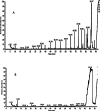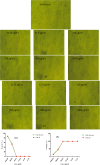Pharmacological activities and phytochemical evaluation of coconut crude oil and upon exposure to ozone
- PMID: 39747767
- PMCID: PMC11695546
- DOI: 10.1186/s13568-024-01813-1
Pharmacological activities and phytochemical evaluation of coconut crude oil and upon exposure to ozone
Abstract
Coconut oil is eatable oil with many nutritional and cosmetic applications. In this investigation coconut oil was subjected to 0 to 5 L/min of ozone for 3 h and the chemical composition of both crude and ozonized oil was valued via Gas Chromatography-Mass Spectrometry (GC-MS). Some biological tests were done including antibacterial action versus Helicobacter pylori, anti-biofilm activity versus H. pylori, anti-hemolytic activity in the existence of H. pylori, anti-Alzheimer action, and cytotoxic effect towards A-413 cancer cell line to determine the activity of coconut oil and upon exposure to ozone. Fifteen compounds were detected in the coconut oil crude and ozonized oils where the fatty acid esters were the most common molecules in crude coconut oil, whereas alkenes were the most predominant compounds in ozonized coconut oil. A slight elevation of antibacterial action towards H. pylori from 23.0 ± 0.1 to 28.2 ± 0.5 mm was displayed upon exposure of the coconut oil to ozone. Both crude and ozonized coconut oil showed a bactericidal effect with MICs = 62.5 ± 0.1, 125.0 ± 0.2 µg/mL and MBCs = 15.62 ± 0.2, 31.25 0.2 µg/mL for crude and ozonized oil, respectively. A significant elevation in anti-biofilm activity was found upon using 25% of MBCs of ozonized oil relative to crude oil. A dramatic rise was observed in anti-hemolytic activity upon using 25 and 75% of MICs of ozonized oil relative to crude one. A notable elevation of anti-Alzheimer impact was evident upon exposing coconut oil to ozone. Besides, the cytotoxic impact towards A-431 cells was slightly increased after exposing the oil to ozone. The current results suggest a new technique to expose coconut oil to ozone to improve some of its in vitro pharmaceutical applications.
Keywords: H. pylori; Anti-Alzheimer; Anti-hemolytic; Coconut; Gas chromatography; Ozone.
© 2024. The Author(s).
Conflict of interest statement
Declarations. Conflict of interest: The authors declare no conflicts of interest.
Figures







Similar articles
-
Phytochemical characterization of peanut oil and its ozonized form to explore biological activities in vitro.AMB Express. 2025 May 14;15(1):76. doi: 10.1186/s13568-025-01849-x. AMB Express. 2025. PMID: 40369380 Free PMC article.
-
Effect of ozonation on the phytochemicals of black seed oil and its anti-microbial, anti-oxidant, anti-inflammatory, and anti-neoplastic activities in vitro.Sci Rep. 2024 Dec 11;14(1):30445. doi: 10.1038/s41598-024-81157-9. Sci Rep. 2024. PMID: 39663384 Free PMC article.
-
Ozonation of sunflower oils: impact of experimental conditions on the composition and the antibacterial activity of ozonized oils.Chem Phys Lipids. 2015 Feb;186:79-85. doi: 10.1016/j.chemphyslip.2015.01.004. Epub 2015 Jan 23. Chem Phys Lipids. 2015. PMID: 25623845
-
Virgin coconut oil: A comprehensive review of antioxidant activity and mechanisms contributed by phenolic compounds.Crit Rev Food Sci Nutr. 2024;64(4):1052-1075. doi: 10.1080/10408398.2022.2113361. Epub 2022 Aug 23. Crit Rev Food Sci Nutr. 2024. PMID: 35997296 Review.
-
A Comprehensive Review of Plant-Based Cosmetic Oils (Virgin Coconut Oil, Olive Oil, Argan Oil, and Jojoba Oil): Chemical and Biological Properties and Their Cosmeceutical Applications.ACS Omega. 2024 Oct 25;9(44):44019-44032. doi: 10.1021/acsomega.4c04277. eCollection 2024 Nov 5. ACS Omega. 2024. PMID: 39524627 Free PMC article. Review.
References
-
- Adedayo BC, Oyeleye SI, Okeke BM, Oboh G (2020) Anti-cholinesterase and antioxidant properties of alkaloid and phenolic-rich extracts from pawpaw (Carica papaya) leaf: a comparative study. Flavour Fragr J 36:47–54
-
- Almehayawi MS, Almuhayawi MS, Abo El-Fadl SR, Nagshabandi MK, Tarabulsi MK, Selim S, Abdelghany TM (2024) Evaluating the anti-yeast, anti-diabetic, wound healing activities of Moringa oleifera extracted at different conditions of pressure via supercritical fluid extraction. BioResources 19(3):55. 10.15376/biores.19.3.5961-5977
-
- Alotaibi HF, Khafagy ES, Abu Lila AS, Alotaibe HF, Elbehairi SE, Alanazi AS, Alfaifi MY, Alamoudi JA, Alamrani SS, Mokhtar FA (2023) Anticancer potentials of metformin loaded coconut oil nanoemulsion on MCF-7, HepG2 and HCT-116 cell lines. Artif Cells Nanomed Biotechnol 51(1):419–427. 10.1080/21691401.2023.2246145 - PubMed
LinkOut - more resources
Full Text Sources
Miscellaneous

